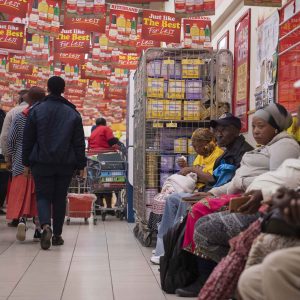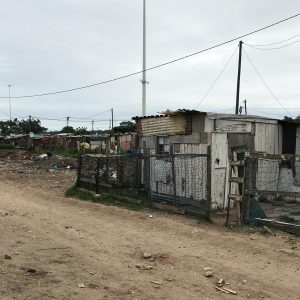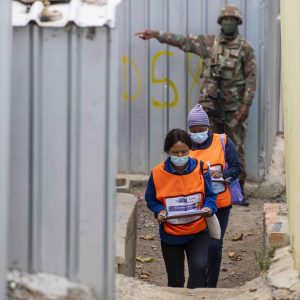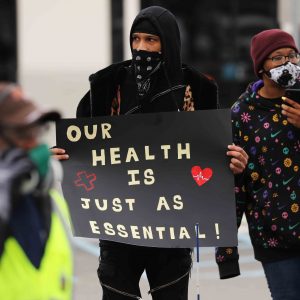Covid-19 stimulus package is a missed opportunity
The economic stimulus package is a band-aid solution whereas South Africa could be using the coronavirus pandemic to address long-term issues of health, public transport and social security.
Author:
24 April 2020

President Cyril Ramaphosa’s R500 billion economic stimulus package was skilfully and deceptively presented to the nation as the real thing. But behind the ballpark figure and the sleight of hand that was supposed to dazzle, a cold and clinical analysis reveals a package that has a pitiful allocation towards the most vulnerable people in society. It provides a woefully inadequate humanitarian response for millions of South Africans who go hungry every day.
Finance Minister Tito Mboweni held the line and ensured that the basic contours of the austerity budget that he presented to Parliament two months ago will remain intact. In other words, the new Covid-19 package will have a limited impact on the budget. Above-the-line measures, which refer to government spending that has a direct impact on its levels of debt, were limited to R160 billion or 3.2% of gross domestic product (GDP). But R130 billion of this amount will be financed by a reprioritisation of spending within the envelope of the austerity budget.
This means that the National Treasury will slash an additional R130 billion from provincial and local grants to provide social infrastructure (including housing, water and transport) on top of cuts of R100 billion that were announced in February. The government will take away R230 billion from infrastructure spending in impoverished areas with one hand and give back only R50 billion in social grants with the other hand. The impoverished will get a social relief of distress (SRD) grant of R325 for only six months while the quality of public services in their areas will continue to decline.
Related article:
As a fiscal stimulus refers to the injection of new money into the economy, the treasury’s net contribution to the stimulus package is only R30 billion or 0.6% of GDP. A reprioritisation of existing government spending within the context of an austerity budget is not a fiscal stimulus. Austerity plus austerity is not equal to a stimulus.
Within the G20 group of the largest advanced and emerging market economies, the average spending on above-the-line measures is 2.9% of GDP, according to the twice-yearly International Monetary Fund Fiscal Monitor report. In the adjustment budget, which Mboweni will present soon, the treasury will provide new estimates for state revenue and expenditure, which are based on a revised GDP growth figure. The February budget was based on a GDP growth rate of 0.9%.
Decline in state revenues
However, the government’s poorly designed and hastily assembled stimulus package will have little impact on GDP growth. The economy is still expected to contract by between six and 10 percentage points in 2020, which will result in the loss of millions of jobs. According to the International Monetary Fund (IMF), the experience of the global financial crisis and past epidemics suggests that state revenues fall even more sharply than a GDP contraction during a recession.
In the wake of the global financial crisis, state revenues in South Africa collapsed by 3%, which was twice the 1.5% GDP contraction. Assuming a GDP contraction of 6%, the likely treasury estimate, state revenues could decline by 9%. This could result in a R230 billion increase in the estimated budget deficit to about R600 billion, equivalent to 13.8% of GDP from an expected 6.8% two months ago. A more plausible 10% GDP contraction would result in a R324 billion increase in the budget deficit to about R700 billion, equivalent to about 14.5% of GDP.
In February, the treasury said South Africa had a net debt of R2.9 trillion, which was equivalent to 57% of GDP. This was not a high number by international standards, even when benchmarked against other middle-income emerging markets. Adding debt of R600 billion to an economy that shrinks by 6% could result in a net debt-to-GDP ratio of about 70%.
Related article:
In a recent paper, Mike Sachs, a Wits University adjunct professor who was previously a deputy director general at the treasury, called for the government to use its entire balance sheet – a financial statement that provides a picture of the state’s assets and liabilities – to bail out the economy. The assets on the national balance sheet include almost R2 trillion in the Public Investment Corporation (PIC), the asset manager of the Government Employees Pension Fund (GEPF) and the Unemployment Insurance Fund (UIF).
After the collapse and subsequent recovery of shares on the JSE stock exchange since the start of the year, the PIC had assets worth about R1.9 trillion at the end of March, according to my estimates. The GEPF had assets of about R1.6 trillion. And the UIF had a surplus (assets minus liabilities) of about R130 billion. The National Revenue Fund, an emergency buffer within the budget, has assets of about R240 billion, according to the treasury. The Reserve Bank has foreign exchange reserves of more than R800 billion.
Sachs said the UIF surplus could be wound down to zero. The GEPF could have a payment holiday and release R75 billion a year. The NRF cash balance meant that the government could finance itself without borrowing on bond markets for about eight months. “The participation of the Reserve Bank in quasi-fiscal operations should not be ruled out,” he said. Quasi-fiscal operations refer to printing money. South African financial institutions also have assets of more than R8 trillion, a portion of which could be steered towards developmental investments (and not the bailout of state-owned companies) when the economy recovers.
Covid-19 quotas
Despite having such a vast national balance sheet, deep capital markets and a Reserve Bank that can finance a stimulus, Ramaphosa said South Africa had approached international financial institutions such as the IMF and the World Bank for funding. The IMF provides funding for countries that have problems with their balance of payments (BoP), a statement that records a country’s financial transactions with the rest of the world. It has a new Covid-19 funding window that has about $100 billion (R1.9 trillion) – almost the size of the South African budget – for all its 189 member countries. The World Bank has a funding window of $14 billion (R266 billion), equivalent to 13% of the South African budget, for all countries.
Based on its quota, South Africa could borrow up to $4.2 billion (R79.8 billion) from the IMF. But it is unlikely that one country would get such a large allocation from the Covid-19 window, which has received 102 applications. To use its quota, South Africa would probably have to also borrow through the normal window, which would involve a dreaded structural adjustment programme. These programmes have punishing conditions that have impoverished many countries in the Global South and in Europe. It is not clear why South Africa should take an IMF loan that would also expose it to foreign exchange risks owing to currency depreciation.
Related article:
Additionally, South Africa does not have a BoP problem. It has a healthy level of foreign exchange reserves. Although the country had capital outflows of R100 billion during the first quarter of 2020, it has a floating exchange rate, which has absorbed the shock without having to deplete its reserves. The rand has depreciated to R19 against the dollar from R14 on 1 January.
Abebe Aemro Selassie, the director of the IMF’s African department, said last week that South Africa’s strength was its very deep and liquid domestic capital markets. “Relative to most emerging market countries, it generates its financing need for the government largely domestically and in its own currency. So that is really a major source of strength that South Africa has.”
Grants and food poverty
Although some of the details of the stimulus package are sketchy, Ramaphosa provided a breakdown of the government’s planned expenditure of R160 billion. It would spend R50 billion on increased social grants, R20 million on public healthcare and R20 billion on water and sanitation, sanitising public transport and providing food and shelter for the homeless. There were also tax measures for businesses that would cost R70 billion. The Department of Social Development had partnered with the Solidarity Fund and community organisations to distribute 250 000 food parcels over the next two weeks.
However, the R50 billion allocation to impoverished households is pitiful in a country where 30.4 million people and 64% of black Africans lived in poverty in 2015, according to Statistics South Africa. The allocation accounts for only 10% of the R500 billion package. In other countries, such measures that transfer income to impoverished households have accounted for up to 50% of stimulus packages. The R325 monthly grant is below the food poverty line of R561. The humanitarian relief in the form of food parcels is woefully inadequate in a country where 13.8 million people (25% of the population) lived below the food poverty line in 2015.
Related article:
Vishwas Satgar, an activist with the South African Food Sovereignty Campaign, says: “The grant for the unemployed is inadequate to meet food needs. It locks the unemployed into a means-tested process [a means test determines who is eligible for assistance], which is going to be a bureaucratic nightmare. We need a basic income grant now. The food measures do not inspire confidence. South Africa has about 30 million people in food stress. Distributing 250 000 food parcels will reach only one million people. The response has been too little and too slow. It does not recognise the scale of the problem.”
Rampahosa said the government had set aside R100 billion for the protection of jobs. But it was not clear whether this commitment referred to above-the-line government spending or the UIF unwinding its surplus. There were no other details. He also announced a R200 billion loan guarantee scheme in partnership with major banks, the treasury and the Reserve Bank. The scheme will support more than 700 000 firms and three million employees.
Smoke and mirrors
There are different ways of looking through the package’s smoke and mirrors to determine what should be counted as real stimulus. The Financial Times newspaper wrote: “Excluding the reprioritised funds and the business loan guarantees, which do not need upfront funds, the package is worth 3% of GDP.”
There is also the view that it may be disingenuous to count loan schemes as stimulus because “the loans may or may not happen.” In an editorial, Business Day newspaper wrote: “There’s no guarantee that this is the amount that will eventually flow into businesses. Commercial banks will presumably not simply discard their usual risk-assessment standards. They might also judge that companies that were solvent before the lockout, well into its fourth week, are no longer so.”
A similar $400 billion scheme in the United Kingdom, which has an 80% government guarantee, has gotten off to a rocky start with loans of only $1.2 billion advanced during the first three weeks owing to complicated application processes and strict lending criteria.
Related article:
A Swiss loan scheme with simple processes has been held up as a model. But it has a 100% guarantee, which means that the banks are distributing state grants.
Peter Attard Montalto, head of research at financial services research firm Intellidex, says the tax revenue deferrals should not count as stimulus because “they are part of the same fiscal year”. If the reprioritisation of government spending, the loan guarantee scheme and the tax measures should not count, what is left of the stimulus package? The government will soon have to top up its package as the jobs bloodbath intensifies and the humanitarian crisis deepens.
United States congresswoman Alexandria Ocasio-Cortez says the coronavirus pandemic has “taken all of these slow-moving crises that we have already been experiencing in the United States and basically pressed fast-forward on every single one”. The same applies in South Africa as Covid-19 has put the spotlight on the country’s multiple crises in health, public transport and social security.
The biggest problem with the stimulus package is that it is a band-aid solution that is designed to offer temporary relief, after which we will return to normal. But as Indian author Arundhati Roy says: “Nothing could be worse than a return to normality. Historically, pandemics have forced humans to break with the past and imagine their world anew. This one is no different. It is a portal, a gateway between one world and the next.”





